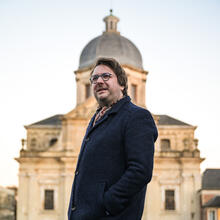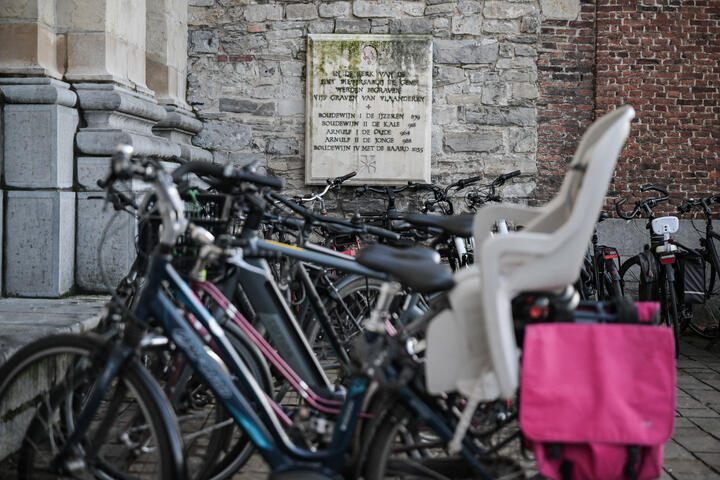

The awful thing about that stone is that the information in the inscription isn't even correct. Baldwin, the first margrave, for example, was buried in Saint-Omer. We know that for sure and that was already known in the 1950s when the stone itself was put up. Another important fact is that Judith, his wife, is also not even named on the stone, even though it was thanks to her that Baldwin got his title in the first place. In fact, a stone plaque with an inscription of this type actually says more about the way in which we wish to view our history – as a story of men in leadership positions – than about history itself.

As academics, we prefer to approach the issue differently, that is, in a way that is more fact-based and precise. We prefer to rely on written sources, archaeological finds and biological research. The best possible scenario comes about when all three disciplines work together, as they did with the skeleton of a woman buried in Ghent more than a thousand years ago.

The tomb of the countess
The ball first began rolling twenty years ago, when the car park was being built under St Peter's Square. If you push a spade into the ground there, at one of the oldest sites in Ghent, you know for a fact that historical finds are bound to turn up. What we hadn't expected though was the number of bodies that would be unearthed there. Dozens and dozens, in fact. In front of the abbey was apparently a cemetery for the medieval beau monde, in a kind of atrium with covered arcades. Only a few cemeteries of this type are known to have existed in Europe as a whole.

To top it off, the archaeologists stumbled upon seven separate graves right in front of the entrance to the old abbey church. The graves themselves dated back around one thousand years ago. That was something very special indeed. In those days, being buried so close to the church was actually not yet possible and was a privilege reserved for someone of the calibre of a bishop or a king. The fact that a woman lay buried there separately, not next to a husband (because her bones are a century older than those of the man in the adjacent grave), captures people's imagination.
Their overriding wish was to get me to state that this skeleton had to be that of Judith, the first countess of Flanders. But I didn't wish to say that, because I wasn't sure.
The story of Flanders
It also captured the imagination of the makers of the TV show Het verhaal van Vlaanderen (The story of Flanders). Their overriding wish was to get me to state that this skeleton had to be that of Judith, the first countess of Flanders. But I didn't wish to say that, because I wasn't sure. At one point, they rolled their eyes, as if to say: “Those pesky academics again!” – and on the fifth take, I gruffly responded, “I don't know!”
In the period that followed, that question still stuck in my mind and also in the mind of the archaeologist Geert Vermeiren. Together, we started getting Ghent's bioanthropologists involved, to see if we could learn more about this mysterious woman's life by examining her bones. In the end, it became a roller-coaster that you dream of experiencing as an academic: researching a crazy theory and then seeing how, with every step you take, it becomes less crazy, until perhaps you discover a new truth... In the end, we devoted an entire exhibition to it and the whole thing was very much like a detective story.

You have to think of this as like a game of ping-pong between historians and bioanthropologists. I provided some bits of information about Judith's life, and based on microscopic and chemical analyses, they then had to try to disprove the hypothesis. But they didn't manage to do so! Is it a woman? Check. A contemporary of Judith? Check. Older than 24? Check. Rich and well-fed? Check. They could even determine that this woman had travelled, which was quite extraordinary for someone at that time – except for someone of great political importance. Someone like Judith, therefore.
Is this Judith, or is it someone else? First and foremost, I'm an academic, and the answer to that question isn't actually written on her forehead, so I can't say for certain. Secretly though, I do hope that DNA testing becomes more advanced in the future, so that we can compare this woman's remains with the bones of Charlemagne... Could she really be his great-granddaughter? (That type of test would only be possible though if the authorities in Aachen were agreeable, of course, as Charlemagne is as revered there as a saint.)
Judith in Ghent?
I have no doubt at all that Judith must have visited Ghent at least a few times. This city was too strategically important for her not to have done so. For that matter, if she could travel forward in time to the present as we know it, she would still recognise a few things, including the location of St Peter's Abbey on a hill next to the Scheldt, and the oldest part of St Bavo's Abbey. The road connecting the two (Sint-Pietersnieuwstraat and its extension) was already an important axis even back then.

Then again, Judith would not have recognised The Castle of the Counts. In the ninth century, there was no fortress on that site that is similar to today's. But she would stand there proudly gloating, I suspect, because of course that building was one of the residences of her grandchildren, the Counts of Flanders. They were the ones that helped put Ghent on the world map. And so without her, without that self-willed Judith, our city could have looked very different today.
Steven Vanderputten
Steven Vanderputten is a professor of history at Ghent University. He conducts scholarly research into our medieval society and culture, with a predilection for the period from the 9th to the 12th century – a period he is definitely does not wish to call ‘the dark Middle Ages’.









